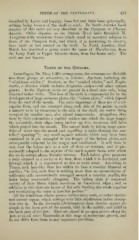Page 403 - My FlipBook
P. 403
TEETH JOF THE VERTEBRATA. 413
described by Lartet and Gaudry, from feet and limb bones principally,
nothing; beino- known of the skull or teeth. In South America fossil
remains of this order are very abundant in the Pampean or Pliocene
deposits. Older deposits on the Parana River have furnished M.
Ameghino with numerous f(jrms which stand in ancestral relation to
those of the Pampean beds, and which, it is interesting to observe,
have more or less enamel on the teeth. In North America, Prof.
Marsh has described a genus under the name of 3forotherium, from
the Loup Fork or Upper Miocene strata, from feet bones only. The
teeth are not known.
Teeth of the Cetacea.
According to Dr. Theo. Gill's arrangement, the cetaceans are divisible
into three groups or sub-orders, as follows : Mysticete, including the
" whalebone whales ;" Denticete, or the " toothed whales," and Zeuglo-
dontia, a division which includes Zeuglodon and» several other extinct
genera. In the 3Iysticete, teeth are present in a foetal state only, being
absorbed before birth. This loss of the teeth is compensated for by the
development of large corneous plates, the " baleen plates," which depend
from the roof of the mouth. The more important of these are of a tri-
angular form, and are arranged along each side of the palate in such
a manner as to be transverse to the axis of the skull, the centre being
occupied by smaller ones, also placed transversely. Altogether, they
form by their extremities a vaulted surface into which the large tongue
fits accurately, their edges being broken up into numerous stiff hairs
which project into the mouth. The animal feeds by taking large quan-
tities of water into the mouth and expelling it again through the nos-
trils (" spouting ") ; any small aquatic animals Avhich may have been
contained in it are entangled in the fringes of the baleen plates, and
subsequently collected by the tongue and swallowed. It will thus be
seen that the baleen acts as a sort of sieve or strainer, and is pre-
eminently adapted to the capture of the small aquatic forms with which
the sea in certain places literally swarms. Each baleen plate possesses
a pulp situated in a cavity at its base, from which it is developed, and
through which it is regenerated as fast as worn away. According to
Tomes, each hair-like fibre has within its base a vascular filament or
papilla; "in fact, each fibre is nothing more than an accumulation of
epidermic cells concentrically arranged around a vascular papilla, the
latter being enormously elongated. The baleen plate is composed
mainly of these fibres, which constitute its frayed-out edges ; and in
addition to this there are layers of flat cells binding the whole together
and constituting the outer or lamellar portion."
All the whalebone whales possess rudimentary teeth, or rather dentine
and enamel organs, which undergo very little calcification before absorp-
tion sets in. In the fin-backs (Bakenopfera) these dentine organs are
simple in the front part of the mouth, bifid in the middle, and trifid in
the back part of the jaw. They are placed in an open groove along the
jaw, as in all other Mammalia at this stage of embryonic growth, and
do not differ from them in any important particular.


